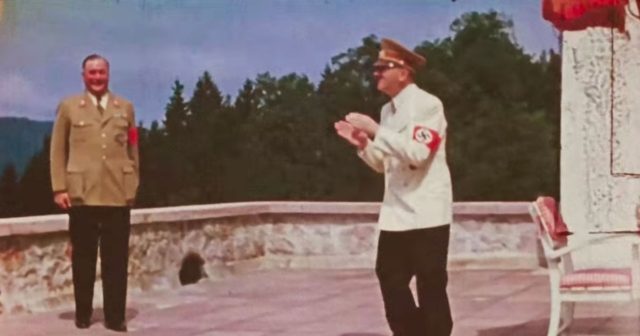
New documentary delves into who Adolf Hitler was and how he rose to power, with rare color footage
THE MEANING OF HITLER (Michael Tucker & Petra Epperlein, 2021)
IFC Center
323 Sixth Ave.
Opens Friday, August 13
www.ifccenter.com
“Has history lost all meaning?” a narrator asks in The Meaning of Hitler. “Is it possible to make a film like this without contributing to the expansion of the Nazi cinematic universe?”
Over the last several decades, the word “Nazi” has been used as a derogatory comment not only for mean-spirited people who enforce their own bizarre rules — think Seinfeld’s Soup Nazi character — but also when political figures don’t like what they believe to be controlling legislation and ideals from a rival party (see Marjorie Taylor Greene). As the word begins to lose its historical reference and becomes normalized — the Nazis are responsible for the senseless, brutal murder of more than thirteen million people, which is anything but normal — so does the name of the man who was the leader of the National Socialists, Adolf Hitler. But the current rise of antisemitism, the election victories of far-right candidates around the world, and the inability of the populace to see through the shady veneer of these demagogues drove husband-and-wife documentarians Michael Tucker and Petra Epperlein to make The Meaning of Hitler. You probably have seen a lot of films about the Holocaust, but not one like this, which delves into who Hitler was, what made him that way, and how we can prevent another similar personality from taking power.
Tucker and Epperlein use Sebasian Haffner’s 1978 book of the same name as a guide as they follow Hitler’s trajectory, from his childhood home, to his failure as an artist, to his first, unsuccessful coup attempt, to his successful march to domination. Do we need more books and films about Hitler? “Perhaps the most extraordinary thing about Hitler is how he resists understanding. There is not one historian, apart from Haffner, who claims to understand him,” says author Martin Amis. “Our understanding of Hitler is central to understanding ourselves. It’s a reckoning you have to make if you’re a serious person.” Professor Yehuda Bauer opines, “You cannot put Hitler on a psychologist’s couch,” while professor Saul Friedländer wishes the filmmakers “Good luck,” intimating that trying to figure out Hitler is a lost cause.
But try they do. In chapters such as “Chaos,” “Legend,” “Hitler Had No Friends,” “The Orator,” “The Hitler Cult,” and “The Good Nazi Years,” taken from Shaffner’s short volume, Tucker and Epperlein travel to Hitler’s ancestral village, the Berlin bunker where he killed himself, Vienna, his Wolf’s Lair headquarters, Flanders, Munich, Berchtesgarden (where Hitler “vacationed” for important photo opportunities), Paris, Warsaw, and Israel, locations where Hitler either lived, visited, or had a major impact on as he utilized the media to spread his message of hate. Forensic biologist Dr. Mark Benecke talks about his examination of Hitler’s skull fragments. Audio guru Klaus Heyne discusses how a new microphone, which became known as the Hitler Bottle, allowed the führer to shout out to impossibly large, adoring crowds, comparing it to the Beatles at Shea Stadium. Archaeologist Wojciech Mazurek describes how they will be digging at the former location of the Sobibor death camp, known as the Unknowable Spot, in order to account for the victims of the Nazis.
The filmmakers (Gunner Palace, Karl Marx City), who wrote, directed, edited, and produced the documentary, with Tucker serving as cinematographer and sound designer as well, give ample time to Holocaust denier David Irving, who offers tours of Nazi sites, celebrating Hitler; while claiming he is not antisemitic, he makes several slurs on camera. He adds, “Forget about Auschwitz; it’s unimportant.” They also speak with professor Deborah Lipstadt, who was sued by Irving for libel but won the court case.
Among the others who share their thoughts on Hitler and the Nazis are Dr. Peter Theiss-Abendroth, historian Sir Richard Evans, author Francine Prose, professor and sociologist Klaus Theweleit, and Nazi hunters Beate and Serge Klarsfeld; they don’t paint a pretty picture, which is how curator Sarah Forgey describes Hitler’s artwork.
Throughout the film, there are short clips of how Hitler and the Nazis have been portrayed in cinema, including scenes from Mel Brooks’s The Producers — yes, “Springtime for Hitler” — The Bunker, Quentin Tarantino’s Inglourious Basterds, Ernst Lubitsch’s To Be or Not to Be, Hitler: Dead or Alive, Leni Riefenstahl’s The Triumph of the Will, and others. But it takes a critical turn when the focus shifts to the current wave of nationalism, anti-immigration, online radicalization, and public demonstrations, particularly related to Donald Trump and the United States. The historians are quite clear about how Trump uses the Hitler playbook in his rhetoric and actions. Professor Ute Frevert notes about Hitler, “It’s consent. He never found anybody who objected. They all said, ‘Well, we believe you. We trust you. We love you,’” which echoes not just how Trump’s cult unconditionally support the former president but what the former TV reality show host said about the rioters who stormed the US Capitol on January 6. And Dr. Mathias Irlinger warns us, “Every year, lots of people come [to Berchtesgarden] because they still believe in Hitler, they still believe in Nazi ideology. The discussion ‘How to deal with the history’ will never stop.”
The revision, whitewashing, and erasure of so much history is why films like The Meaning of Hitler must continue to be made, especially as the last generation of Holocaust survivors and witnesses pass away. If we don’t figure out “What made Hitler Hitler?,” as the film asks, how can we say it will never happen again, even in our own backyard?